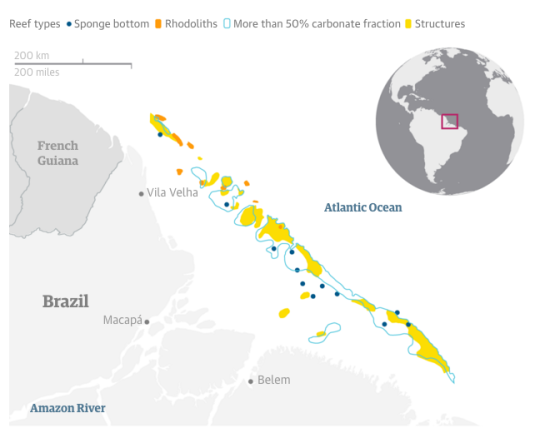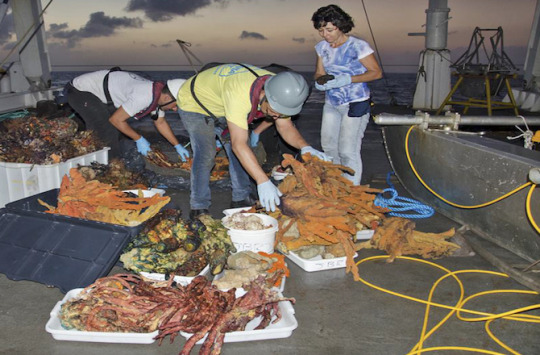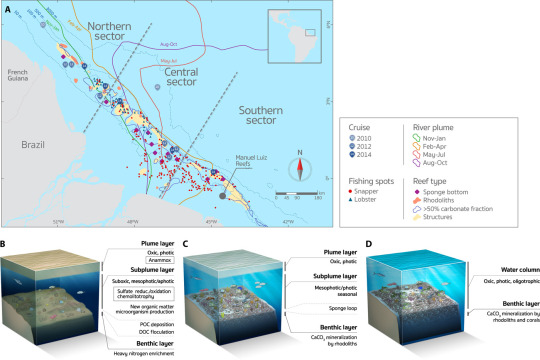#rhodoliths
This discovery just goes to show how much we still have to learn about our wonderful oceans!
A big team of scientists publishedtheir findings on April 22, 2016, in the journal ScienceAdvances (you can access the paper for free!). It is quite an astonishing find, as the reef is located in very muddy and polluted waters, but it also stretches over 600 miles!

The reef ranges from depths of 30m to 120m, and consists primarily of sponges and rhodoliths (a type of marine algae that resemble coral), rather than corals. Researchers found over 60 species of sponges, 73 species of fish, spiny lobsters, sea stars, hydroids, and other marine organisms.
Reef ecosystems are known to thrive in very clear and shallow water, with plenty of sunlight and oxygen flow, with stable salinity conditions and low nutrients.
This reef is somehow thriving right below the freshwater outflow of the Amazon river, where vast quantities of sediments coming down the river are swept to the sea. The muddy plume is even visible from space! On top of that, light is very low and almost non-existent, levels of oxygen are also very poor, and nutrients levels are through the roof (333,000 nutrients per second as it flows).

(Scientists shown with specimens they collected from the newly discovered reef. Photo credit: F. Moraes/Courtesy of Carlos Rezende (UENF) and Fabiano Thompson (UFRJ))
Fabiano Thompson, one of the authors of the paper, told Discovery News,“There were some studies back in the 1950s that suggested the presence of reefs, but none pinpointed the reef bodies, dimensions, locations, and compositions.”
Until this study, nobody really had followed up on these. The researchers were originally primarily focused on sampling the mouth of the Amazon. However, Dr. Moura, primary author of the study, had read an article from the 1970s that mentioned catching reef fish in that location, and he wanted to try to locate the reefs. The team first used multibeam acoustic sampling of the ocean bottom to find the reef and then dredged up samples to confirm the discovery.
They then organized another expedition with a full team and took a Brazilian Navy research vessel back to the site in 2014, when they were able to collect and fully describe the findings for the study.
The video below is provided by Science Advances and shows scientists and marine biologists “sampling the plume, subplume, and reefs off the Amazon river mouth during the NHo Cruzeiro do Sul cruise.”
This paper could provide insight how tropical reefs respond to suboptimal and marginal reef-building conditions, which may become more prevalent with the onset of climate change.
“The paper is not just about the reef itself, but about how the reef community changes as you travel north along the shelf break, in response to how much light it gets seasonally by the movement of the plume,”said Patrica Yager, an associate professor of marine sciences at the University of Georgia.
“In the far south, it gets more light exposure, so many of the animals are more typical reef corals and things that photosynthesize for food. But as you move north, many of those become less abundant, and the reef transitions to sponges and other reef builders that are likely growing on the food that the river plume delivers. So the two systems are intricately linked.”

(Map of the Amazon shelf showing the benthic megahabitats and seasonal influence of the river plume. Click here to enlarge)
Sadly,this location is already threatened. Parts of the area have been sold by the Brazilian government to the petroleum industry in 2013 for oil exploration and drilling. Some exploratory blocks are already producing oil in close proximity to the reef, with many more to come.
As a result, the scientists are calling for further studies of the area in order to properly map its marine life diversity, as they have only sampled about 10-20% of it.
